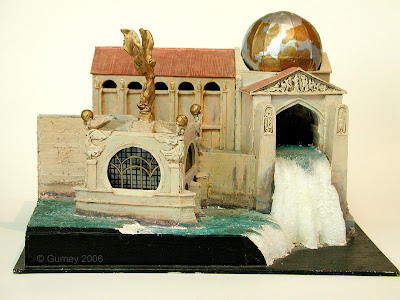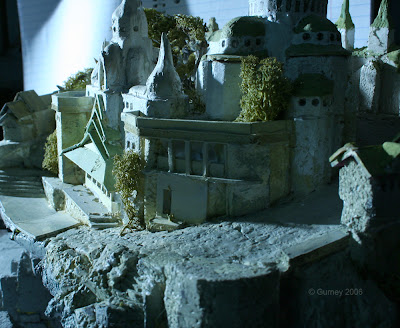
This model, which I made for a painting in the first Dinotopia book, is constructed from plaster-soaked burlap for the mountain forms, and mat board for the buildings, assembled with a hot glue gun. The whole thing is coated with gesso and colored with acrylic.

This corner of Waterfall City has about four days of work in it. It served as reference for several different paintings in The World Beneath and Chandara. It's made from cardboard, styrofoam, and two-part epoxy putty for the sculptural details. The original maquette is currently on view in the Dinotopia exhibition at the Los Angeles Public Library.

I made this little model for a painting of Chandara, but I’ve had it kicking around the studio, and I’ve used it in other ways. Here the light is tinted with a blue gel to suggest moonlight. The rough texture in the foreground is the broken surface of the styrofoam. I took the photo with a digital SLR set to a high f-stop and a long time exposure to give it maximum depth of field. Printed out on paper, the photo was one of many that provided a starting point for a painting of the desert city of Khasra in the new book. The trees are bits of dried moss from my backyard.
 This 45-minute clay maquette also helped with Khasra. It shows how quick and loose an architectural maquette can be and still give you plenty of lighting information. Note the beautiful light bouncing into the shadows on the right side. The shadows on the tower on the extreme right are much darker because they lack reflected light. That's the kind of information I'm interested in.
This 45-minute clay maquette also helped with Khasra. It shows how quick and loose an architectural maquette can be and still give you plenty of lighting information. Note the beautiful light bouncing into the shadows on the right side. The shadows on the tower on the extreme right are much darker because they lack reflected light. That's the kind of information I'm interested in.
The arch here is hot-glued from foam-core and mat board, with domes of styrofoam balls. I coated the structure with gesso and modeling paste and painted it in acrylic. I set up the model alongside toy wooden blocks as a kind of 3-D sketch for the marketplace scene below. A miniature set like this can be placed under an artificial spotlight or outdoors in direct sunlight.
The silver Christmas tree ball provides a record of the entire surrounding light environment. You need this information to really understand the combined effects of various light sources on any given object in the scene. If you look closely at the reflection in the silver ball you can see the arched window and skylights of my studio, and my own dome behind the camera. If the photo had been taken in outdoor light, the light effects would be slightly different, and so would the reflection in the silver ball.

Many of these methods of using miniatures are low-budget home versions of techniques used in the film special effects industry. They really don’t take much time—you can build and shoot a model in half a day—but they yield great dividends in your final results.







9 comments:
I love this posts, where you explain the way you work
Do you ever build digital models?
Not exactly clear on what the purpose of the christmas ball serves, could you clarify?
The silver ball gives you an exact record of the source and character of the light sources acting on a scene. You can tell the exact position of the sun or key light and whether the sky is blue or cloudy--which affects the quality of the shadows.
It takes a while to get used to interpreting this information, but once you do, it's like having a compass in the woods.
You need it especially if you're compositing separately photographed elements into a single scene. In my case I paint a scene in oil, but I still need to know the global light map. The people in the movie FX industry pioneered this technique.
I was just going to comment that I've seen people from ILM using it on some of their movies to somehow help them on the lighting setup for the computer rendering process until I read that last comment.
But, I still can't get it how does it help you on your paintings...
I kind of know that it does helps record your environment, but what difference does it make when you have different surroundings? How do you apply that information to your paintings?
Oh, and by the way, I just got a copy of two of your books. I really wanted to get the hardcovers this time around because my older The World Beneath copy, which is a softcover book, isn't standing the weight of time and use (and i've taken the most care with it).
I'm marvelled at the detail you put on this universe.
So, I know this is an old post, but how did you do the water for the Waterfall City corner? I was thinking epoxy resin, but I don't know how clearly that dries...
BTW, I've been reading your books ever since they came out. They're fantastic, and inspired me to start drawing seriously. Thank you, for making them.
Hi, Marchurio,
The water was just white packaging styrofoam. The top surface of it was impregnated with acrylic modeling paste and painted with acrylic paint. Very simple to make, but it did the job.
Thank you for an excellent weblog !! I discovered some useful information and will suggest your blog for all my buddies.
RicoMoco
Post a Comment